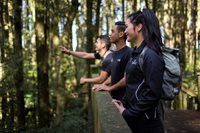Wendy-Lee McKee-Warner’s love for art started at high school, where she spent all her time hanging out in the art room.
“I didn't go to school to eat my lunch. I went to school to paint,” she says.
“It’s always been something I’ve been passionate about, I connect well with paint and putting stuff on canvas.”
She has put that passion to good use, and is now completing her final year of the Maunga Kura Toi Māori and Indigenous Art degree programme in Hastings.
Wife and mother of two Wendy-Lee (Rongomaiwahine) started at Te Wānanga o Aotearoa when school wasn't working for her daughter. They both signed up to do the 18-week Toi Maruata programme, with Wendy-Lee acting as a support person to her daughter to help relieve her anxiety.
“My daughter loves art but she suffers from depression and anxiety,” Wendy-Lee says.
“I saw art as a therapy for her to let out all her worries or sorrows out on canvas. We didn’t understand the history of art, the lingo or the computer stuff. I’m sure if they had it in a picture, we would have got it better, but everyone here helps you and encourages you, even if it’s uncomfortable.” Wendy-Lee says she was happy she could start her Toi journey with her daughter.
“I thought wow, we are home. This is where we are supposed to be.”
Wendy’s daughter didn’t carry on with her studies but Wendy-Lee continued to navigate her way through different techniques and forms of visual art. She is still learning about different artists and art mediums and appreciates all types of art forms, particularly those that express soft lines, as she hopes people look at her works they might feel calm and relaxed from all the craziness in the world.
Wendy-Lee is currently exhibiting in both Tuakana Teina and Hira exhibitions, with her piece Trouble being the exhibition piece in the show.
She was “over the moon” when given the opportunity to show her works at a dealer gallery and credits her kaiako for all the encouragement she received to finish her work.
Opening the Arts New Zealand magazine and seeing her artworks was another proud moment for Wendy-Lee.
Her pieces Trouble and Havoc 2021 were created from an artist study on William Morris and Wendy-Lee says she struggled with these artworks, as we had gone through another lockdown and she had separated from her Toi whānau.
“I had chosen blue hue colours, it was a dark piece. My kaiako were very supportive, always there for me and I pushed the painting from being dark to light, keeping its softness and fluidness.”
Wendy-Lee’s goal is to become a full-time artist and continue with her te reo Māori and tikanga studies to help her whānau and others.
Find out more about our Toi Māori programmes.




































